
X-plane
Encyclopedia
The X-planes are a series of experimental United States
airplanes
and helicopter
s (and some rocket
s) used for the testing and evaluation of new technologies and aerodynamic concepts. Some members of the series have been well publicised, while others, such as the X-16 project, have been developed in secrecy.
The first of the X-planes, the Bell X-1
, became well known as, in 1947, it was the first aircraft to break the sound barrier
in level flight. Later X-planes yielded important research results in a multitude of aerodynamic and technical fields, but only the North American X-15
rocket plane of the early 1960s achieved comparable fame to that of the X-1. X-planes 7 through 12 were actually missiles
(used to test new types of engines), and some other vehicles were un-piloted (some were remotely flown, some were full-on drones). Most X-planes are not expected to go into full-scale production, however an exception to the rule was the Lockheed Martin X-35
, which competed against the Boeing X-32
in a fly-off as part of the Joint Strike Fighter Program
, and has entered into production as the F-35.
Most of the X-planes have been operated by the National Advisory Committee for Aeronautics
(NACA) or, later, the National Aeronautics and Space Agency (NASA), often in conjunction with the United States Air Force
. However, not all US experimental aircraft have been designated in the X-plane series; some received U.S. Navy designations prior to 1962, while others have been known only by manufacturers' designations, non-'X'-series designations, or classified codenames.
United States
The United States of America is a federal constitutional republic comprising fifty states and a federal district...
airplanes
Fixed-wing aircraft
A fixed-wing aircraft is an aircraft capable of flight using wings that generate lift due to the vehicle's forward airspeed. Fixed-wing aircraft are distinct from rotary-wing aircraft in which wings rotate about a fixed mast and ornithopters in which lift is generated by flapping wings.A powered...
and helicopter
Helicopter
A helicopter is a type of rotorcraft in which lift and thrust are supplied by one or more engine-driven rotors. This allows the helicopter to take off and land vertically, to hover, and to fly forwards, backwards, and laterally...
s (and some rocket
Rocket
A rocket is a missile, spacecraft, aircraft or other vehicle which obtains thrust from a rocket engine. In all rockets, the exhaust is formed entirely from propellants carried within the rocket before use. Rocket engines work by action and reaction...
s) used for the testing and evaluation of new technologies and aerodynamic concepts. Some members of the series have been well publicised, while others, such as the X-16 project, have been developed in secrecy.
The first of the X-planes, the Bell X-1
Bell X-1
The Bell X-1, originally designated XS-1, was a joint NACA-U.S. Army/US Air Force supersonic research project built by Bell Aircraft. Conceived in 1944 and designed and built over 1945, it eventually reached nearly 1,000 mph in 1948...
, became well known as, in 1947, it was the first aircraft to break the sound barrier
Sound barrier
The sound barrier, in aerodynamics, is the point at which an aircraft moves from transonic to supersonic speed. The term, which occasionally has other meanings, came into use during World War II, when a number of aircraft started to encounter the effects of compressibility, a collection of several...
in level flight. Later X-planes yielded important research results in a multitude of aerodynamic and technical fields, but only the North American X-15
North American X-15
The North American X-15 rocket-powered aircraft/spaceplane was part of the X-series of experimental aircraft, initiated with the Bell X-1, that were made for the USAAF/USAF, NACA/NASA, and the USN. The X-15 set speed and altitude records in the early 1960s, reaching the edge of outer space and...
rocket plane of the early 1960s achieved comparable fame to that of the X-1. X-planes 7 through 12 were actually missiles
Missile
Though a missile may be any thrown or launched object, it colloquially almost always refers to a self-propelled guided weapon system.-Etymology:The word missile comes from the Latin verb mittere, meaning "to send"...
(used to test new types of engines), and some other vehicles were un-piloted (some were remotely flown, some were full-on drones). Most X-planes are not expected to go into full-scale production, however an exception to the rule was the Lockheed Martin X-35
Lockheed Martin X-35
The Lockheed Martin X-35 was an experimental aircraft developed by Lockheed Martin for the Joint Strike Fighter Program. It was declared the winner over the Boeing X-32 and went on to enter production in the early 21st century as the F-35 Lightning II....
, which competed against the Boeing X-32
Boeing X-32
The Boeing X-32 was a multi-purpose jet fighter in the Joint Strike Fighter contest. It lost to the Lockheed Martin X-35 demonstrator which was further developed into the F-35 Lightning II.-Background:...
in a fly-off as part of the Joint Strike Fighter Program
Joint Strike Fighter Program
Joint Strike Fighter is a development and acquisition program intended to replace a wide range of existing fighter, strike, and ground attack aircraft for the United States, the United Kingdom, Canada, and their allies. After a competition between the Boeing X-32 and the Lockheed Martin X-35, a...
, and has entered into production as the F-35.
Most of the X-planes have been operated by the National Advisory Committee for Aeronautics
National Advisory Committee for Aeronautics
The National Advisory Committee for Aeronautics was a U.S. federal agency founded on March 3, 1915 to undertake, promote, and institutionalize aeronautical research. On October 1, 1958 the agency was dissolved, and its assets and personnel transferred to the newly created National Aeronautics and...
(NACA) or, later, the National Aeronautics and Space Agency (NASA), often in conjunction with the United States Air Force
United States Air Force
The United States Air Force is the aerial warfare service branch of the United States Armed Forces and one of the American uniformed services. Initially part of the United States Army, the USAF was formed as a separate branch of the military on September 18, 1947 under the National Security Act of...
. However, not all US experimental aircraft have been designated in the X-plane series; some received U.S. Navy designations prior to 1962, while others have been known only by manufacturers' designations, non-'X'-series designations, or classified codenames.
List of X-planes
| Name | Manufacturer Agency |
Image | Maiden flight | Purpose and Notes |
|---|---|---|---|---|
| X-1 Bell X-1 The Bell X-1, originally designated XS-1, was a joint NACA-U.S. Army/US Air Force supersonic research project built by Bell Aircraft. Conceived in 1944 and designed and built over 1945, it eventually reached nearly 1,000 mph in 1948... |
Bell Aircraft Bell Aircraft The Bell Aircraft Corporation was an aircraft manufacturer of the United States, a builder of several types of fighter aircraft for World War II but most famous for the Bell X-1, the first supersonic aircraft, and for the development and production of many important civilian and military helicopters... USAF, NACA NACA - Organizations :* National Advisory Committee for Aeronautics, the forerunner of the U.S. federal agency NASA* National Association for Campus Activities, an organization for programmers of university and college activities... |
 |
January 19, 1946 | High-speed and high-altitude testing. First aircraft to break the sound barrier Sound barrier The sound barrier, in aerodynamics, is the point at which an aircraft moves from transonic to supersonic speed. The term, which occasionally has other meanings, came into use during World War II, when a number of aircraft started to encounter the effects of compressibility, a collection of several... . Proved aerodynamic viability of thin wing sections. |
| X-2 "Starbuster" Bell X-2 -Popular culture:* The 1956 film Toward the Unknown starred the X-2, William Holden, Lloyd Nolan and Virginia Leith. A brainwashed former POW tries to return to test flying; co-starring the Martin XB-51 and the Edwards AFB flight line.... |
Bell Aircraft USAF |
June 27, 1952 | High-speed and high-altitude testing. First aircraft to exceed Mach 3 Mach number Mach number is the speed of an object moving through air, or any other fluid substance, divided by the speed of sound as it is in that substance for its particular physical conditions, including those of temperature and pressure... . |
|
| X-3 Stiletto X-3 Stiletto The Douglas X-3 Stiletto was a 1950s United States experimental jet aircraft with a slender fuselage and a long tapered nose, manufactured by the Douglas Aircraft Company. Its primary mission was to investigate the design features of an aircraft suitable for sustained supersonic speeds, which... |
Douglas Aircraft USAF, NACA |
 |
October 27, 1952 | Titanium Titanium Titanium is a chemical element with the symbol Ti and atomic number 22. It has a low density and is a strong, lustrous, corrosion-resistant transition metal with a silver color.... alloy construction; low aspect ratio Aspect ratio The aspect ratio of a shape is the ratio of its longer dimension to its shorter dimension. It may be applied to two characteristic dimensions of a three-dimensional shape, such as the ratio of the longest and shortest axis, or for symmetrical objects that are described by just two measurements,... wings. Planned to test long-duration high-speed flight. Incapable of reaching design speed, but Provided insights into inertia coupling Inertia coupling Inertia coupling is a potentially lethal phenomenon of high-speed flight in which the inertia of the heavier fuselage overpowers the aerodynamic stabilizing forces of the wing and empennage... . |
| X-4 Bantam |
Northrop Northrop Corporation Northrop Corporation was a leading United States aircraft manufacturer from its formation in 1939 until its merger with Grumman to form Northrop Grumman in 1994. The company is known for its development of the flying wing design, although only a few of these have entered service.-History:Jack... USAF, NACA |
December 15, 1948 | Evaluated handling characteristics of tailless aircraft Tailless aircraft A tailless aircraft traditionally has all its horizontal control surfaces on its main wing surface. It has no horizontal stabilizer - either tailplane or canard foreplane . A 'tailless' type usually still has a vertical stabilising fin and control surface... in the transonic Transonic Transonic speed is an aeronautics term referring to the condition of flight in which a range of velocities of airflow exist surrounding and flowing past an air vehicle or an airfoil that are concurrently below, at, and above the speed of sound in the range of Mach 0.8 to 1.2, i.e. 600–900 mph... speed region. |
|
| X-5 Bell X-5 -See also:-Bibliography:* Hallion, Richard P. On The Frontier: Flight Research At Dryden 1946-1981 . Washington, DC: National Aeronautics and Space Administration, 1984 . ISBN 1-58834-134-8.... |
Bell Aircraft USAF, NACA |
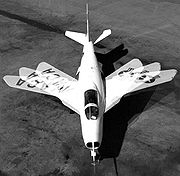 |
June 20, 1951 | First aircraft to fly with variable geometry wings. |
| X-6 Convair X-6 -See also:*Project Pluto*Project Rover*NERVA*WS-125Comparable aircraft* Tupolev Tu-119-External links:* original published on Aviation History, March 1995.* Section devoted to NB-36H... |
Convair Convair Convair was an American aircraft manufacturing company which later expanded into rockets and spacecraft. The company was formed in 1943 by the merger of Vultee Aircraft and Consolidated Aircraft, and went on to produce a number of pioneering aircraft, such as the Convair B-36 bomber, and the F-102... USAF, AEC United States Atomic Energy Commission The United States Atomic Energy Commission was an agency of the United States government established after World War II by Congress to foster and control the peace time development of atomic science and technology. President Harry S... |
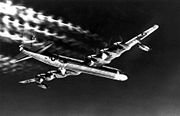 |
Not flown | Modified Convair B-36 Convair B-36 The Convair B-36 "Peacemaker" was a strategic bomber built by Convair and operated solely by the United States Air Force from 1949 to 1959. The B-36 was the largest mass-produced piston engine aircraft ever made. It had the longest wingspan of any combat aircraft ever built , although there have... for study of Aircraft Nuclear Propulsion Aircraft Nuclear Propulsion The Aircraft Nuclear Propulsion program and the preceding Nuclear Energy for the Propulsion of Aircraft project worked to develop a nuclear propulsion system for aircraft. The United States Army Air Force initiated Project NEPA on May 28, 1946... ; not built. NB-36H testbed Testbed A testbed is a platform for experimentation of large development projects. Testbeds allow for rigorous, transparent, and replicable testing of scientific theories, computational tools, and new technologies.The term is used across many disciplines to describe a development environment that is... tested reactor. |
| X-7 "Flying Stove Pipe" Lockheed X-7 -See also:-External links:*... |
Lockheed Lockheed Corporation The Lockheed Corporation was an American aerospace company. Lockheed was founded in 1912 and later merged with Martin Marietta to form Lockheed Martin in 1995.-Origins:... Tri-service United States Department of Defense The United States Department of Defense is the U.S... |
 |
April 1951 | High-speed testbed for ramjet engines. |
| X-8 Aerobee Aerojet General X-8 -See also:-External links:*... |
Aerojet Aerojet Aerojet is an American rocket and missile propulsion manufacturer based primarily in Rancho Cordova, California with divisions in Redmond, Washington, Orange, Gainesville and Camden, Arkansas. Aerojet is owned by GenCorp. They are the only US propulsion company that provides both solid rocket... NACA, USAF, USN |
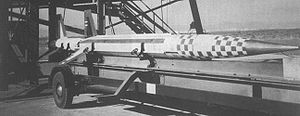 |
Upper air research vehicle and sounding rocket. | |
| X-9 Shrike X-9 Shrike The Bell Aircraft Corporation X-9 Shrike was a prototype surface-to-air, liquid-fueled guided missile that was a testbed for the nuclear-armed GAM-63 RASCAL. It is named after the bird shrike.... |
Bell Aircraft USAF |
 |
April 1949 | Guidance and propulsion technology testbed. Assisted development of GAM-63 Rascal GAM-63 RASCAL The GAM-63 RASCAL is a supersonic Air-to-surface missile that was developed by the Bell Aircraft Company. The RASCAL was the United States Air Force's first nuclear armed standoff missile. The RASCAL was initially designated the ASM-A-2, then re-designated the B-63 in 1951 and finally re-designated... missile. |
| X-10 North American X-10 The North American X-10 was an unmanned technology demonstrator for advanced missile technologies during the 1950s. The X-10 was similar to the development of Bell's X-9 Shrike project.-Development:... |
North American Aviation North American Aviation North American Aviation was a major US aerospace manufacturer, responsible for a number of historic aircraft, including the T-6 Texan trainer, the P-51 Mustang fighter, the B-25 Mitchell bomber, the F-86 Sabre jet fighter, the X-15 rocket plane, and the XB-70, as well as Apollo Command and Service... USAF |
 |
October 13, 1953 | Testbed for SM-64 Navajo missile. |
| X-11 | Convair USAF |
June 11, 1957 | Testbed for SM-65 Atlas missile. | |
| X-12 | Convair USAF |
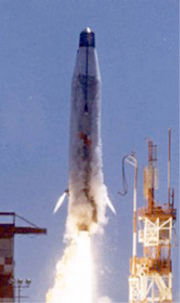 |
July, 1958 | Advanced testbed for SM-65 Atlas missile. |
| X-13 Vertijet |
Ryan Aeronautical Ryan Aeronautical Company The Ryan Aeronautical Company was founded by T. Claude Ryan in San Diego, California in 1934. Part of Teledyne after 1969, Northrop Grumman purchased Teledyne Ryan in 1999... USAF, USN |
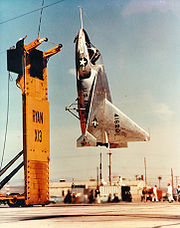 |
December 10, 1955 | Vertical takeoff and landing (VTOL) testbed. Evaluated tailsitting Tailsitter A tailsitter is a type of VTOL aircraft that launches and lands on its tail. One of the most famous examples of this type of aircraft is the Ryan X-13 Vertijet. Among the propeller-driven versions were the Lockheed XFV, and the Convair XFY Pogo. Studies and wind tunnel models were made of a... configuration for VTOL flight. |
| X-14 | Bell Aircraft USAF, NASA |
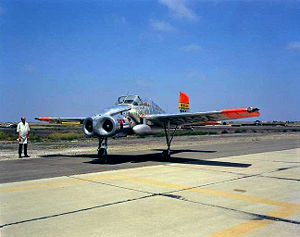 |
February 19, 1957 | VTOL testbed. Examined the vectored thrust configuration for VTOL flight. |
| X-15 North American X-15 The North American X-15 rocket-powered aircraft/spaceplane was part of the X-series of experimental aircraft, initiated with the Bell X-1, that were made for the USAAF/USAF, NACA/NASA, and the USN. The X-15 set speed and altitude records in the early 1960s, reaching the edge of outer space and... |
North American Aviation USAF, NASA |
 |
June 8, 1959 | Hypersonic Hypersonic In aerodynamics, a hypersonic speed is one that is highly supersonic. Since the 1970s, the term has generally been assumed to refer to speeds of Mach 5 and above... (Mach 6), high-altitude (350000 feet (106,680 m)) testing.First manned hypersonic aircraft; capable of suborbital spaceflight. |
| X-16 | Bell Aircraft USAF |
Never flew | High-altitude reconnaissance aircraft Reconnaissance aircraft A reconnaissance aircraft is a manned military aircraft designed, or adapted, to carry out aerial reconnaissance.-History:The majority of World War I aircraft were reconnaissance designs... project. "X-16" designation used as cover story. |
|
| X-17 Lockheed X-17 The Lockheed X-17 was a three stage solid-fuel research rocket to test the effects of high mach atmospheric reentry. The first stage of the X-17 carried the rocket to a height of before burning out. The rocket would then coast on momentum to about before nosing down for reentry. The second stage... |
Lockheed USAF, USN |
 |
April 1956 | Tested the effects of high Mach number reentry Atmospheric reentry Atmospheric entry is the movement of human-made or natural objects as they enter the atmosphere of a celestial body from outer space—in the case of Earth from an altitude above the Kármán Line,... . |
| X-18 Hiller X-18 The X-18 was an experimental cargo transport aircraft designed to be the first testbed for tiltwing and VSTOL technology.-Development:... |
Hiller Aircraft Hiller Aircraft Hiller Aircraft Company was founded in 1942 as Hiller Industries by Stanley Hiller to develop helicopters.- History :Stanley Hiller, then seventeen, established the first helicopter factory on the West Coast of the United States, located in Berkeley, California, in 1942, under the name "Hiller... USAF, USN |
 |
November 24, 1959 | VTOL/Short take-off and vertical landing (STOVL) testbed. Evaluated the tiltwing Tiltwing A tiltwing aircraft features a wing that is horizontal for conventional forward flight and rotates up for vertical takeoff and landing. It is similar to the tiltrotor design where only the propeller and engine rotate. Tiltwing aircraft are typically fully capable of VTOL operations.The tiltwing... concept for VTOL flight. |
| X-19 Curtiss-Wright X-19 |-See also:-External links:*... |
Curtiss-Wright Curtiss-Wright The Curtiss-Wright Corporation was the largest aircraft manufacturer in the United States at the end of World War II, but has evolved to largely become a component manufacturer, specializing in actuators, aircraft controls, valves, and metalworking.... Tri-service |
 |
November 1963 | Tandem Quadrotor A quadrotor, also called a quadrotor helicopter or quadrocopter, is an aircraft that is lifted and propelled by four rotors. Quadrotors are classified as rotorcraft, as opposed to fixed-wing aircraft, because their lift is derived from four rotors... tiltrotor Tiltrotor A tiltrotor is an aircraft which uses a pair or more of powered rotors mounted on rotating shafts or nacelles at the end of a fixed wing for lift and propulsion, and combines the vertical lift capability of a helicopter with the speed and range of a conventional fixed-wing aircraft... VTOL transport testbed. XC-143 designation proposed. |
| X-20 Dyna-Soar X-20 Dyna-Soar The X-20 Dyna-Soar was a United States Air Force program to develop a spaceplane that could be used for a variety of military missions, including reconnaissance, bombing, space rescue, satellite maintenance, and sabotage of enemy satellites... |
Boeing Boeing The Boeing Company is an American multinational aerospace and defense corporation, founded in 1916 by William E. Boeing in Seattle, Washington. Boeing has expanded over the years, merging with McDonnell Douglas in 1997. Boeing Corporate headquarters has been in Chicago, Illinois since 2001... USAF |
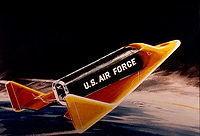 |
Never built | Reusable spaceplane Spaceplane A spaceplane is a vehicle that operates as an aircraft in Earth's atmosphere, as well as a spacecraft when it is in space. It combines features of an aircraft and a spacecraft, which can be thought of as an aircraft that can endure and maneuver in the vacuum of space or likewise a spacecraft that... for military missions. |
| X-21 Northrop X-21 -See also:-Bibliography:* Winchester, Jim. X-Planes and Prototypes. London: Amber Books Ltd., 2005. ISBN 1-904687-40-7.* Retrieved: 14 February 2007.-External links:* *... |
Northrop USAF |
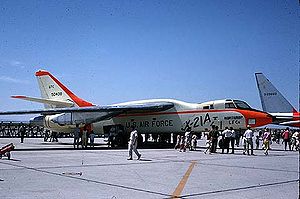 |
April 18, 1963 | Boundary layer control Boundary layer control Boundary layer control refers to methods of controlling the behaviour of fluid flow boundary layers. This holds particular interest in aeronautical engineering because drag may be reduced whilst achieving high lift .... testbed. |
| X-22 Bell X-22 -References:NotesBibliography* Markman, Steve and Bill Holder. Straight Up: A History of Vertical Flight. Atglen, PA: Schiffer Publishing, 2000. ISBN 0-7643-1204-9.... |
Bell Aircraft Tri-service |
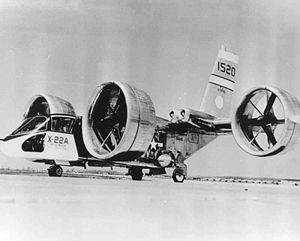 |
March 17, 1966 | Quad ducted fan Ducted fan A ducted fan is a propulsion arrangement whereby a fan, which is a type of propeller, is mounted within a cylindrical shroud or duct. The duct reduces losses in thrust from the tip vortices of the fan, and varying the cross-section of the duct allows the designer to advantageously affect the... tiltrotor STOVL testbed. |
| X-23 PRIME |
Martin Marietta Martin Marietta Martin Marietta Corporation was an American company founded in 1961 through the merger of The Martin Company and American-Marietta Corporation. The combined company became a leader in chemicals, aerospace, and electronics. In 1995, it merged with Lockheed Corporation to form Lockheed Martin. The... USAF |
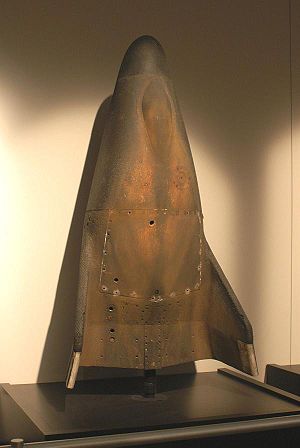 |
December 21, 1966 | Manuvering atmospheric reentry Atmospheric reentry Atmospheric entry is the movement of human-made or natural objects as they enter the atmosphere of a celestial body from outer space—in the case of Earth from an altitude above the Kármán Line,... effects testbed. Note: Designation never officially assigned. |
| X-24 | Martin Marietta USAF, NASA |
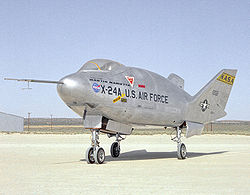  |
August 1, 1973 | Low-speed lifting body Lifting body A lifting body is a fixed-wing aircraft configuration in which the body itself produces lift. In contrast to a flying wing, which is a wing with minimal or no conventional fuselage, a lifting body can be thought of as a fuselage with little or no conventional wing... handling testbed. Lifting body aerodynamic shape trials. |
| X-25 | Benson Bensen Aircraft The Bensen Aircraft Corporation was established by Dr. Igor Bensen at Raleigh-Durham International Airport in North Carolina in 1952 to develop and market a variety of helicopters and autogyros of Bensen's own design.... USAF |
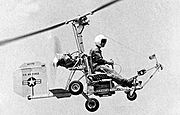 |
December 6, 1955 | Light autogyro Autogyro An autogyro , also known as gyroplane, gyrocopter, or rotaplane, is a type of rotorcraft which uses an unpowered rotor in autorotation to develop lift, and an engine-powered propeller, similar to that of a fixed-wing aircraft, to provide thrust... for emergency use by downed pilots. |
| X-26 Frigate |
Schweizer DARPA, US Army, USN |
|
1967 | Training glider Glider aircraft Glider aircraft are heavier-than-air craft that are supported in flight by the dynamic reaction of the air against their lifting surfaces, and whose free flight does not depend on an engine. Mostly these types of aircraft are intended for routine operation without engines, though engine failure can... for yaw-roll coupling Dutch roll Dutch roll is a type of aircraft motion, consisting of an out-of-phase combination of "tail-wagging" and rocking from side to side. This yaw-roll coupling is one of the basic flight dynamic modes... Quiet observation aircraft testbed. |
| X-27 | Lockheed | 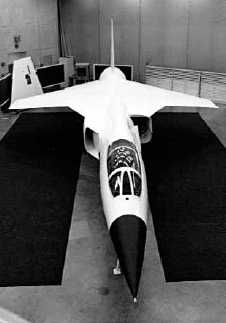 |
Never flew | High performance fighter prototype. |
| X-28 Sea Skimmer |
Osprey Aircraft George Pereira Brigadier-General George Edward Pereira, CB, CMG, DSO was a British explorer in Central Asia, Tibet and Western China; a soldier, writer and diplomatist.-Early life and family:... USN |
August 12, 1970 | Inexpensive aerial policing seaplane testbed. | |
| X-29 Grumman X-29 |-See also:-References:NotesBibliography* Thruelsen, Richard. The Grumman Story. New York: Praeger Publishers, Inc., 1976. ISBN 0-275-54260-2.... |
Grumman DARPA, USAF, NASA |
 |
1984 | Forward-swept wing Forward-swept wing A forward-swept wing is an aircraft wing configuration in which the quarter-chord line of the wing has a forward sweep. The configuration was first proposed in 1936 by German aircraft designers.Perceived benefits of a forward-swept wing design include... testbed. |
| X-30 NASP Rockwell X-30 -See also:-References: 2. -External links:*... |
Rockwell Rockwell International Rockwell International was a major American manufacturing conglomerate in the latter half of the 20th century, involved in aircraft, the space industry, both defense-oriented and commercial electronics, automotive and truck components, printing presses, valves and meters, and industrial automation.... NASA, DARPA, USAF |
 |
Never built | Single stage to orbit spaceplane prototype. |
| X-31 Rockwell-MBB X-31 |-See also:-References:*Jenkins, Dennis R., Tony Landis, and Jay Miller. . NASA, June 2003.*USAF & NATO Report RTO-TR-015 AC/323//TP-1 .-External links:* * * *... |
Rockwell DARPA, USAF, BdV |
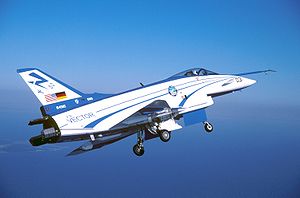 |
1990 | Thrust vectoring Thrust vectoring Thrust vectoring, also thrust vector control or TVC, is the ability of an aircraft, rocket or other vehicle to manipulate the direction of the thrust from its engine or motor in order to control the attitude or angular velocity of the vehicle.... supermaneuverability Supermaneuverability Supermaneuverability is the quality of aircraft defined as a threshold of attitude control exceeding that which is possible by pure aerodynamic maneuverability; in other words, a controlled loss of control beyond normal abilities... testbed.ESTOL testbed. |
| X-32 Boeing X-32 The Boeing X-32 was a multi-purpose jet fighter in the Joint Strike Fighter contest. It lost to the Lockheed Martin X-35 demonstrator which was further developed into the F-35 Lightning II.-Background:... |
Boeing USAF, USN, RAF Royal Air Force The Royal Air Force is the aerial warfare service branch of the British Armed Forces. Formed on 1 April 1918, it is the oldest independent air force in the world... |
September 2000 | Joint Strike Fighter Joint Strike Fighter Program Joint Strike Fighter is a development and acquisition program intended to replace a wide range of existing fighter, strike, and ground attack aircraft for the United States, the United Kingdom, Canada, and their allies. After a competition between the Boeing X-32 and the Lockheed Martin X-35, a... prototype. |
|
| X-33 Venture Star Lockheed Martin X-33 The Lockheed Martin X-33 was an unmanned, sub-scale technology demonstrator suborbital spaceplane developed in the 1990s under the U.S. government-funded Space Launch Initiative program. The X-33 was a technology demonstrator for the VentureStar orbital spaceplane, which was planned to be a... |
Lockheed Martin Lockheed Martin Lockheed Martin is an American global aerospace, defense, security, and advanced technology company with worldwide interests. It was formed by the merger of Lockheed Corporation with Martin Marietta in March 1995. It is headquartered in Bethesda, Maryland, in the Washington Metropolitan Area.... NASA |
Prototype never completed | Half-scale reusable launch vehicle prototype. | |
| X-34 Orbital Sciences X-34 The Orbital Sciences X-34 was intended as a low-cost testbed to demonstrate "key technologies" integratable to the Reusable Launch Vehicle program.... |
Orbital Sciences NASA |
 |
Never flew | Reusable unmanned spaceplane testbed. |
| X-35 Lockheed Martin X-35 The Lockheed Martin X-35 was an experimental aircraft developed by Lockheed Martin for the Joint Strike Fighter Program. It was declared the winner over the Boeing X-32 and went on to enter production in the early 21st century as the F-35 Lightning II.... |
Lockheed Martin USAF, USN, RAF |
 |
2000 | Joint Strike Fighter prototype. |
| X-36 | McDonnell Douglas McDonnell Douglas McDonnell Douglas was a major American aerospace manufacturer and defense contractor, producing a number of famous commercial and military aircraft. It formed from a merger of McDonnell Aircraft and Douglas Aircraft in 1967. McDonnell Douglas was based at Lambert-St. Louis International Airport... /Boeing Boeing The Boeing Company is an American multinational aerospace and defense corporation, founded in 1916 by William E. Boeing in Seattle, Washington. Boeing has expanded over the years, merging with McDonnell Douglas in 1997. Boeing Corporate headquarters has been in Chicago, Illinois since 2001... NASA |
 |
May 17, 1997 | 28% scale tailless fighter Tailless aircraft A tailless aircraft traditionally has all its horizontal control surfaces on its main wing surface. It has no horizontal stabilizer - either tailplane or canard foreplane . A 'tailless' type usually still has a vertical stabilising fin and control surface... testbed. |
| X-37 Boeing X-37 The Boeing X-37 is an American unmanned vertical-takeoff, horizontal-landing spaceplane. The X-37 is operated by the United States Air Force for orbital spaceflight missions intended to demonstrate reusable space technologies... |
Boeing USAF, NASA |
April 7, 2006 (drop test) April 22, 2010 (orbital flight) |
Reusable orbital spaceplane. | |
| X-38 | Scaled Composites Scaled Composites Scaled Composites is an aerospace company founded by Burt Rutan and currently owned by Northrop Grumman that is located at the Mojave Spaceport, Mojave, California, United States... NASA |
 |
1999 | Lifting body Crew Return Vehicle Crew Return Vehicle The Crew Return Vehicle , sometimes referred to as the Assured Crew Return Vehicle , is the proposed lifeboat or escape module for the International Space Station... demonstrator. |
| X-39 | Unknown USAF |
Classified | Unknown | Future Aircraft Technology Enhancements (FATE) program. Note: Designation never officially assigned. |
| X-40 Boeing X-40 -See also:-External links:* * * * *... |
Boeing USAF, NASA |
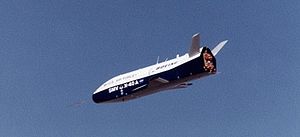 |
August 11, 1998 | 80% scale Space Maneuver Vehicle testbed. X-37 prototype. |
| X-41 X-41 Common Aero Vehicle X-41 is the designation for a still-classified U.S. military spaceplane. Specifications or photos of the program have not been released to the public yet; as a result not much is known about its goals... |
Unknown USAF |
Classified | Unknown | Maneuvering re-entry vehicle. |
| X-42 X-42 Pop-Up Upper Stage X-42 is the designation of a still-classified U.S. military space project. Specifications or photos of the program have not been released to the public; as a result not much is known about its goals... |
Unknown USAF |
Classified | Unknown | Expendable liquid propellant upper stage rocket. |
| X-43 Hyper-X |
Microcraft NASA |
June 2, 2001 | Scramjet Scramjet A scramjet is a variant of a ramjet airbreathing jet engine in which combustion takes place in supersonic airflow... hypersonic testbed. |
|
| X-44 MANTA X-44 MANTA |-References:* Miller, Jay. The X-Planes: X-1 to X-45. Hinckley, UK: Midland, 2001. ISBN 1-85780-109-1.-External links:* Day, Dwayne A. . centennialofflight.gov... |
Lockheed Martin USAF, NASA |
Cancelled | F-22-based Multi-Axis No-Tail Aircraft thrust vectoring testbed. | |
| X-45 Boeing X-45 The Boeing X-45 unmanned combat air vehicle is a concept demonstrator for a next generation of completely autonomous military aircraft, developed by Boeing's Phantom Works. Manufactured by Boeing Integrated Defense Systems, the X-45 was a part of DARPA's J-UCAS project.-Development:Boeing developed... |
Boeing DARPA, USAF |
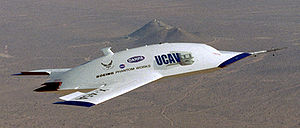  |
May 22, 2002 | Unmanned combat air vehicle Unmanned Combat Air Vehicle An unmanned combat air vehicle or combat drone is an unmanned aerial vehicle that is designed to deliver weapons without an onboard pilot. Currently operational UCAVs are under real-time human control, but future version may enable autonomous operation, for example with pre-programmed route and... (UCAV) demonstrator. |
| X-46 Boeing X-46 The Boeing X-46 was a proposed unmanned combat air vehicle that was to be developed in conjunction with the U.S. Navy and DARPA as a naval carrier-based variant of the Boeing X-45 UCAV being developed for the U.S. Air Force... |
Boeing DARPA, USN |
 |
Cancelled | Naval UCAV demonstrator. |
| X-47A Pegasus X-47B Northrop Grumman X-47B |-See also:-External links:* and * * * * - TFOT magazine**... |
Northrop Grumman Northrop Grumman Northrop Grumman Corporation is an American global aerospace and defense technology company formed by the 1994 purchase of Grumman by Northrop. The company was the fourth-largest defense contractor in the world as of 2010, and the largest builder of naval vessels. Northrop Grumman employs over... DARPA, USN |
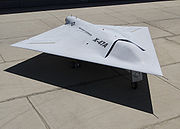 |
February 23, 2003 | Naval UCAV demonstrator. |
| X-48 Boeing X-48 The X-48 is an experimental unmanned aerial vehicle for investigation into the characteristics of blended wing body aircraft, a type of flying wing. It is under development by Boeing and NASA.-Background:... |
Boeing NASA |
July 20, 2007 | Blended Wing Body Blended wing body Blended Wing Body aircraft have a flattened and airfoil shaped body, which produces most of the lift, the wings contributing the balance. The body form is composed of distinct and separate wing structures, though the wings are smoothly blended into the body... (BWB) testbed. |
|
| X-49 Speedhawk |
Piasecki Aircraft Piasecki Aircraft Piasecki Aircraft Corporation was founded by American vertical flight pioneer, the late Frank Piasecki, to continue pursuing the development of compound helicopters and other advanced rotorcraft.-History:... US Army |
 |
July 29, 2007 | Compound helicopter Vectored Thrust Ducted Propeller (VTDP) testbed. |
| X-50 Dragonfly Boeing X-50 The Boeing X-50A Dragonfly, formerly known as the Canard Rotor/Wing Demonstrator, was a gyrodyne unmanned aerial vehicle that was developed by Boeing and DARPA to demonstrate the principle that a helicopter's rotor could be stopped in flight and act as a fixed wing... |
Boeing DARPA |
24 November 2003 | Canard Rotor/Wing Canard Rotor/Wing The Canard Rotor/Wing is a class of VTOL aircraft capable of both fixed-wing and rotary-wing flight. For vertical take-off, hovering, low-speed flight, and vertical landing, the main airfoil is spun like a helicopter's rotor by directing the exhaust from a jet engine through thrust nozzles in the... testbed. |
|
| X-51 Waverider Boeing X-51 The Boeing X-51 is an unmanned scramjet demonstration aircraft for hypersonic flight testing. It successfully completed its first free-flight on 26 May 2010 and also achieved the longest duration flight at speeds over Mach 5.The X-51 Waverider program is run as a cooperative effort of the United... |
Boeing USAF |
 |
26 May 2010 | Hypersonic scramjet demonstrator. |
| X-52 | Number skipped to avoid confusion with B-52. | |||
| X-53 | Boeing Phantom Works Boeing Phantom Works The Phantom Works division is the advanced prototyping arm of the Defense and Security side of The Boeing Company. Its primary focus is developing advanced military products and technologies, many of them highly classified, and has produced breakthroughs in defense, space and security.Founded by... NASA, USAF |
November 2002 | Active Aeroelastic Wing Active Aeroelastic Wing The X-53 Active Aeroelastic Wing development program is a completed research project that was undertaken jointly by the Air Force Research Laboratory , Boeing Phantom Works and NASA's Dryden Flight Research Center, where the technology was flight tested on a modified McDonnell Douglas F/A-18 Hornet... testbed. |
|
| X-54 Gulfstream X-54 |-See also:-References:NotesBibliography*. Jane's Information Group.*, AOPA Online, October 6, 2008. Byline: "By AOPA Publications staff". Fetched from Web 26 April 2010.*, MDS Designators allocated 1998-2009. Accessed 2011-01-07.... |
Gulfstream Aerospace Gulfstream Aerospace Gulfstream Aerospace Corporation is a producer of several models of jet aircraft. Gulfstream has been a unit of General Dynamics since 1999.The company has produced more than 1,500 aircraft for corporate, government, private, and military customers around the world... NASA |
Future | Supersonic transport Supersonic transport A supersonic transport is a civilian supersonic aircraft designed to transport passengers at speeds greater than the speed of sound. The only SSTs to see regular service to date have been Concorde and the Tupolev Tu-144. The last passenger flight of the Tu-144 was in June 1978 with its last ever... testbed. |
|
| X-55 | Lockheed Martin Skunk Works Skunk works Skunk Works is an official alias for Lockheed Martin’s Advanced Development Programs , formerly called Lockheed Advanced Development Projects. Skunk Works is responsible for a number of famous aircraft designs, including the U-2, the SR-71 Blackbird, the F-117 Nighthawk, and the F-22 Raptor... USAF |
June 2, 2009 | Advanced Composite Cargo Aircraft (ACCA). Molded composite fuselage Fuselage The fuselage is an aircraft's main body section that holds crew and passengers or cargo. In single-engine aircraft it will usually contain an engine, although in some amphibious aircraft the single engine is mounted on a pylon attached to the fuselage which in turn is used as a floating hull... and empennage Empennage The empennage , also known as the tail or tail assembly, of most aircraft gives stability to the aircraft, in a similar way to the feathers on an arrow... testbed. |
|
See also
- Experimental aircraftExperimental aircraftAn experimental aircraft is an aircraft that has not yet been fully proven in flight. Often, this implies that new aerospace technologies are being tested on the aircraft, though the label is more broad....
- List of experimental aircraft
- List of military aircraft of the United States

